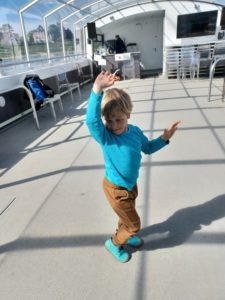Imogen
Share This Post
Imogen was born following a pregnancy that was generally normal. There was a slight complication by threatened premature labour at 32 weeks, but she held on and was born at 38 weeks by assisted delivery. Imogen’s feeding was identified as being a challenge from the early days of life and her sleep cycle was extremely poor. She had her first “obvious” apnoea secondary to seizures on day 4 which led to being flown via air ambulance to a large hospital in the closest city. Numerous investigations were undertaken including an EEG, MRI, genetics and metabolic screenings.
Before Imogen was 2, she experienced a significant number of complex medical emergencies – 6 different hospitals, twice intubated and 14 ambulance rides. more testing was conducted including lumbar punctures. Everything that was tested for came back as ‘normal’.
Imogen sat for the first time at 10 months, crawled for the first time at 15 months and walked for the first time at 2 ½ years. She still (at 17 years old) has an unsteady and wide gait and poor balance and co-ordination. She has no speech. She has only about 2 signs that she uses for communication. (‘more’ and ‘toilet.) It took years to toilet train her, but this has been successful, however she is unable to take care of her own hygiene. Puberty commenced at 10 years of age.
Imogen’s seizures are refractory. her current medication cocktail (which is giving her reasonable control) is: Zonegran (zonisimide), Ospolot (Sulthaime) Vimpat (Lacosomide), Frisium (clobazam), Tegratol, Clonodine (catapress).
she is also on Melatonin (to go to sleep) the contraceptive pill (ethinylestradiol) and we have Midazolam (intranazal) for emergency prolonged seizures.
She has been on many other Anti-epileptic drugs over the years, all of which were deemed as failures.
Imogen was finally diagnosed (after sending DNA overseas many times)- in November 2021. They found she has de novo likely pathogenic variant to the GRIA2 gene technically written as c.2420C>T This variant has apparently not been inherited by myself or my husband. Imogen has a perfectly neurotypical sister (same parents) who is 20 years old.
Imogen has difficulties processing auditory information. She is easily distracted by noise. This behaviour indicates she has an under-responsive auditory system and so she seeks auditory input, however this also distracts her from the task at hand. Imogen has difficulties processing touch information through her skin and mouth. She dislikes wearing clothes, as well as fingernail cutting, teeth cleaning and hair brushing. She also displays a high tolerance for pain. These behaviours indicate she is over responsive to touch. She requires predictable touch to organize her sensory system. She also has an under-responsive proprioceptive system.
Overall, as you can see Imogen is a highly complex human and it is often heartbreaking for us to witness how frustrating, challenging and cruel life can be for her. Immi needs intensive support in all aspects of daily life, around the clock – 24/7. Despite everything, Immi is a social butterfly. Her eye contact is captivating, her laugh is infectious, she is cheeky beyond words. She loves music, animals, cause and effect toys and ALWAYS needs to be the centre of attention!
If there is any advice I can give to GRIA2 parents with younger children it would be – hang in there! Our complex kids turn into really beautiful humans and we cannot imagine life without her. Having said that however, I really hope we can further research for GRI disorders and more specifically GRIA2 for our family.
Read more Posts

Artur
Artur is a positive, friendly boy, not shy, and very sweet. Artur welcomes everybody with open arms and gives you the feeling you are the hero of the day.

Danica
Our family knew something wasn’t right when she could not lift up her head. Danica started therapy when she was about 9 months old. That’s also when we got the diagnosis of GRIN1.
